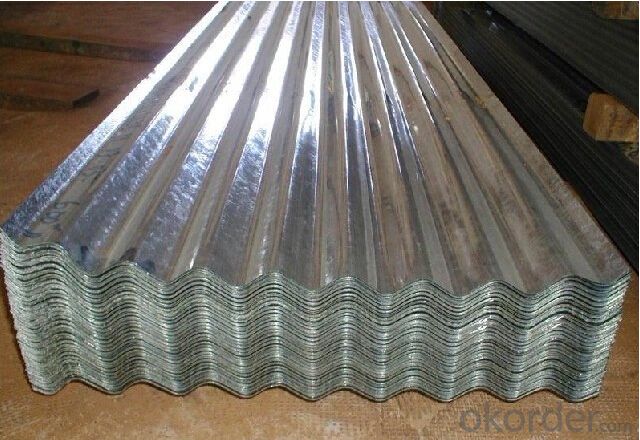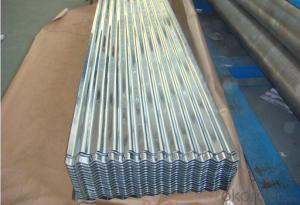High quality of corrugated steel coil from north of China
- Loading Port:
- Tianjin
- Payment Terms:
- TT OR LC
- Min Order Qty:
- 50 m.t.
- Supply Capability:
- 100000 m.t./month
OKorder Service Pledge
OKorder Financial Service
You Might Also Like
1. Hot-Dip Galvanized Steel Roof Description:
Hot-dip galvanized steel roof are available with a pure zinc coating through the hot-dip galvanizing process. It offers the economy, strength and formability of steel combined with the corrosion resistance of zinc. The hot-dip process is the process by which steel gets coated in layers of zinc to protect against rust. It is especially useful for countless outdoor and industrial application.
2.Main Features of the Hot-Dip Galvanized Steel Roof:
• Excellent process capability
• Smooth and flat surface
• Workability, durability
• Excellent heat resistance performance
• High strength
• Good formability
• Good visual effect
3.Hot-Dip Galvanized Steel Roof Images

4.Hot-Dip Galvanized Steel Roof Specification
Material: Galvanized Sheet
Width: 650/800/890/900
Length: 1500/1800/2000/2400/3005/3600 or customized
Thickness: 0.2-2.0
Surface Treatment: Hot dipped/Bended
Application: warehouse; shelter; Commercial facilities; industrial facilities
5.FAQ of Hot-Dip Galvanized Steel Roof
Which payment term we can do?
L/C at sight or T/T.
What’s the basic material of this product?
Galvanized/Aluzinc Steel
- Q:I would like to build steel galvanization plant.
- bcaz of the very corrosive conditions in petrochemical plants, steel without coating doesnt work. coating with zinc (e. g. hot dip galvanizing) help protecting the steel for more time, in simple words , zinc is corroded instead of iron and until there is some zinc on the surface steel is protected. we usualy dont use paint coating bcaz: 1.any porosity in the paint coat result in severe corrosion and steel should be completely coated with paint to be protected ,instead large prosity in zinc coating doesnt matter at all 2. usual painting materials arent proper for the severe corrosive condition ASTM standard( american society for testing and materials) offer world accepted standards for painting quality control
- Q:How are steel coils used in the production of steel locks?
- Steel coils are used in the production of steel locks as they provide the raw material needed for manufacturing lock components such as lock bodies, shackle, and tumblers. The steel coils are processed and shaped into various lock parts, which are then assembled to create the final product.
- Q:how is stainless steel made? what are the things used in making it?
- There are 3 basic stainless steels. The Martinsitic, the ferritic, and the Austinistic. The spelling may be wrong on all of them. (Got out of school in 1966 with my metallurgy in 1965. The Ferritic is magnetic and has some resistance to corrosion but the Martinsitic is much more resistant to corrosion. The Austinitic stainless is very resistant to corrosion. The differences are the amount of Chrome and Nickel in the batches. The Austinitic has an 18/8 ratio of Chromium and Nickel with the rest Iron and minor ingredients. The carbon content is very important and these steels are often made in small batches with close monitoring of composition and carbon content. Scrap metals are frequently used with the chrome and nickel being added as carefully selected scrap or even fresh crude stocks. Electric melting is frequent to avoid contamination.
- Q:like, what can steel make?
- buildings bridges automobiles elevators railroads and railroad equipment appliances and many many more. Steel is used almost everywhere. reference: Iron and steel are used widely in the construction of roads, railways, infrastructure, and buildings. Most large modern structures, such as stadiums and skyscrapers, bridges, and airports, are supported by a steel skeleton. Even those with a concrete structure will employ steel for reinforcing. In addition to widespread use in major appliances and cars (Despite growth in usage of aluminium, it is still the main material for car bodies.), steel is used in a variety of other construction-related applications, such as bolts, nails, and screws.[66] Other common applications include shipbuilding, pipeline transport, mining, offshore construction, pipeline transport, aerospace, white goods (e.g. washing machines), heavy equipment (e.g. bulldozers), office furniture, steel wool, tools, and armour in the form of personal vests or vehicle armour (better known as rolled homogeneous armour in this role). .
- Q:which elements are alloyed to make stainless steel?A Fe, CB Fe, MnC Fe, NiD Fe, CrE Fe, Cr, Ni
- E. Stainless steel is mainly comprised of Cr and Ni. Steel is an alloy composed mainly of iron. On a side note, Carbon is not really in stainless steel and it is only less than .1%
- Q:What are the different types of steel coil storage racks?
- There are several types of steel coil storage racks, including coil cradles, coil saddles, coil c-hooks, and coil racks with dividers.
- Q:What are the challenges in coil blanking for complex shapes?
- Coil blanking for complex shapes poses several challenges, primarily due to the intricate nature of the shapes involved. One significant challenge is achieving precision and accuracy in cutting the coils to create the desired shape. Complex shapes often require intricate cuts and tight tolerances, which necessitates advanced cutting techniques and machinery. Additionally, maintaining consistency throughout the entire coil length can be challenging, as any deviation can result in imperfect shapes. Furthermore, handling and manipulating the coils during the blanking process can be difficult, especially if the shapes are intricate or delicate. Overall, the challenges in coil blanking for complex shapes revolve around achieving precise cuts, maintaining consistency, and effectively handling the coils to ensure high-quality finished products.
- Q:What are the limitations of using steel coils in certain applications?
- Steel coils have a few limitations that may restrict their use in certain applications. Firstly, steel coils can be heavy and bulky, making them less suitable for applications where weight reduction is crucial. For instance, in industries such as aerospace or automotive, where lightweight materials are preferred to enhance fuel efficiency and improve performance, steel coils may not be the most suitable choice. Secondly, steel coils are vulnerable to corrosion, especially in environments with high moisture or exposure to chemicals. This limitation can restrict their use in applications where resistance to corrosion is crucial, such as marine or coastal structures. Additional protective coatings or regular maintenance may be required to mitigate this limitation, adding to the overall cost and maintenance efforts. Moreover, steel coils may not possess the necessary flexibility or malleability required for certain applications. In industries such as construction or manufacturing, where materials need to be easily shaped or bent into specific forms, steel coils might not offer the desired level of flexibility. This limitation can lead to difficulties in achieving desired designs or may require additional processing steps to mold the steel coils into the desired shape. Lastly, steel coils can have limitations in terms of their temperature resistance. In high-temperature applications, such as in furnaces or power generation, steel coils may experience thermal expansion or deformation, which can compromise their structural integrity. In such cases, alternative materials with higher temperature resistance, such as refractory metals or ceramics, may be more suitable. Overall, while steel coils are widely used and versatile materials, their limitations in terms of weight, corrosion resistance, flexibility, and temperature resistance can restrict their use in certain applications. It is crucial to consider these limitations and assess the specific requirements of the application when selecting materials for optimal performance and durability.
- Q:What are the dimensions of steel coils?
- The dimensions of steel coils can vary depending on the specific application and industry. However, they are typically available in widths ranging from 0.5 inches to 72 inches and thicknesses ranging from 0.005 inches to 0.5 inches. The length of steel coils can vary as well, but they are commonly found in lengths of 100 feet to 1000 feet.
- Q:What are the different methods of punching steel coils?
- There are several methods of punching steel coils, including mechanical punching, hydraulic punching, and laser punching. Mechanical punching involves the use of a mechanical press with a punch and die set to create holes or shapes in the steel coil. Hydraulic punching utilizes hydraulic force to drive a punch through the coil, providing high precision and speed. Laser punching, on the other hand, uses a laser beam to cut or form holes in the steel coil, offering great flexibility and accuracy. Each method has its own advantages and suitability depending on the specific requirements of the application.
1. Manufacturer Overview |
|
|---|---|
| Location | |
| Year Established | |
| Annual Output Value | |
| Main Markets | |
| Company Certifications | |
2. Manufacturer Certificates |
|
|---|---|
| a) Certification Name | |
| Range | |
| Reference | |
| Validity Period | |
3. Manufacturer Capability |
|
|---|---|
| a)Trade Capacity | |
| Nearest Port | |
| Export Percentage | |
| No.of Employees in Trade Department | |
| Language Spoken: | |
| b)Factory Information | |
| Factory Size: | |
| No. of Production Lines | |
| Contract Manufacturing | |
| Product Price Range | |
Send your message to us
High quality of corrugated steel coil from north of China
- Loading Port:
- Tianjin
- Payment Terms:
- TT OR LC
- Min Order Qty:
- 50 m.t.
- Supply Capability:
- 100000 m.t./month
OKorder Service Pledge
OKorder Financial Service
Similar products
New products
Hot products
Related keywords





























